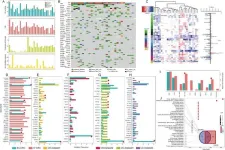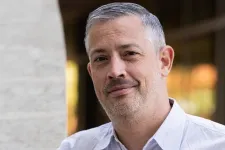(Press-News.org) CLEVELAND–Life’s random rhythms surround us–from the hypnotic, synchronized blinking of fireflies…to the back-and-forth motion of a child’s swing… to slight variations in the otherwise steady lub-dub of the human heart.
But truly understanding those rhythms—called stochastic, or random, oscillations—has eluded scientists. While researchers and clinicians have some success in parsing brain waves and heartbeats, they’ve been unable to compare or catalogue an untold number of variations and sources.
Gaining such insight into the underlying source of oscillations “could lead to advances in neural science, cardiac science and any number of different fields,” said Peter Thomas, a professor of applied mathematics at Case Western Reserve University.
Thomas is part of an international team that says it has developed a novel, universal framework for comparing and contrasting oscillations--regardless of their different underlying mechanisms—which could become a critical step toward someday fully understanding them.
Their findings were recently published in Proceedings of the National Academy of Sciences.
“We turned the problem of comparing oscillators into a linear algebra problem,” Thomas said. “What we have done is vastly more precise than what was available before. It's a major conceptual advance.”
The researchers say others can now compare, better understand—and even manipulate—oscillators previously considered to have completely different properties.
“If your heart cells aren’t synchronized, you die of atrial fibrillation,” Thomas said. “But if your brain cells synchronize too much, you have Parkinson's disease, or epilepsy, depending on which part of the brain the synchronization occurs in. By using our new framework, that heart or brain scientist may be able to better understand what the oscillations could mean and how the heart or brain is working or changing over time.”
Swaying skyscrapers and brain waves
Thomas said the researchers—who included collaborators from universities in France, Germany and Spain—found a new way to use complex numbers to describe the timing of oscillators and how “noisy,” or imprecisely timed, they are.
Most oscillations are irregular to some extent, Thomas said. For example, a heart rhythm is not 100% regular. A natural variation of 5-10% in the heartbeat is considered healthy.
Thomas said the problem with comparing oscillators can be illustrated by considering two markedly different examples: brain rhythms and swaying skyscrapers.
“In San Francisco, modern skyscrapers sway in the wind, buffeted by randomly shifting air currents—they’re pushed slightly out of their vertical posture, but the mechanical properties of the structure pull them back,” he said. “This combination of flexibility and resilience helps high-rise buildings survive shaking during earthquakes. You wouldn’t think this process could be compared with brain waves, but our new formalism lets you compare them.”
How their findings might help either discipline—mechanical engineering and neuroscience—may be unknown right now, Thomas said, comparing the conceptual advance to when Galileo discovered Jupiter’s orbiting moons.
“What Galileo realized was a new point of view, and while our discovery is not as far-reaching as Galileo's, it is similarly a change in perspective,” he said. “What we report in our paper is an entirely new point of view on stochastic oscillators.”
###
Case Western Reserve University is one of the country's leading private research institutions. Located in Cleveland, we offer a unique combination of forward-thinking educational opportunities in an inspiring cultural setting. Our leading-edge faculty engage in teaching and research in a collaborative, hands-on environment. Our nationally recognized programs include arts and sciences, dental medicine, engineering, law, management, medicine, nursing and social work. About 6,000 undergraduate and 6,300 graduate students comprise our student body. Visit case.edu to see how Case Western Reserve thinks beyond the possible.
END
Making sense of life’s random rhythms
International research team, including Case Western Reserve University mathematician, suggests universal framework for understanding ‘oscillations’
2023-08-15
ELSE PRESS RELEASES FROM THIS DATE:
Robotic exoskeletons and neurorehabilitation for acquired brain injury: Determining the potential for recovery of overground walking
2023-08-15
East Hanover, NJ. August 15, 2023. A team of New Jersey researchers reviewed the evidence for the impact of robotic exoskeleton devices on recovery of ambulation among individua5ls with acquired brain injury, laying out a systematic framework for the evaluation of such devices that is needed for rigorous research studies. The open access article, "Lower extremity robotic exoskeleton devices for overground ambulation recovery in acquired brain injury – A review” (doi: 10.3389/fnbot.2023/1014616), was published ...
New genetic relations between irritable bowel syndrome and psychiatric diseases discovered
2023-08-15
We have all felt the workings of the so called “brain-gut-axis”, how our intestines get affected, for example, by stress. But still, researchers don’t know a lot about the relation between our gut and our brain.
Research has identified genetic correlations between patients suffering from irritable bowel syndrome (IBS) and psychiatric disorders, such as bipolar disorder.
By using new statistical methods, developed at NORMENT Centre, Post Doctor Markos Tesfaye at the University of Bergen and University of Oslo and his colleagues working under the leadership ...
First-of-its-kind study reveals predictive factors for outcomes of advanced stage AL amyloidosis
2023-08-15
(WASHINGTON, August 15, 2023) – Early improvements in cardiac and hematologic parameters may predict better survival outcomes for patients being treated for stage IIIb AL amyloidosis, a deadly disease with a median survival of 4-6 months caused by abnormal protein buildup, according to new research released today in Blood Advances.
Amyloidosis occurs when normal proteins in the body misfold and form amyloid deposits in vital organs and tissues, which can lead to organ dysfunction, failure, and death. The prognosis for patients with advanced cardiac amyloidosis is extremely poor, ...
Innovative research on schistosomiasis-associated colorectal cancer (SA-CRC) yields unique insights into genetic mutations and treatment implications
2023-08-15
In a study published in the journal Genes & Diseases, researchers from Naval Medical University and Soochow University conducted an in-depth investigation into the genomic landscape of schistosomiasis-associated colorectal cancer (SA-CRC). By utilizing whole exome sequencing on tumor tissues and their non-tumor counterparts obtained from thirty SA-CRC patients diagnosed at Changzheng Hospital from 2014 to 2020, the team successfully identified 2476 nonsynonymous mutations spanning across 1978 genes. This intricate analysis revealed a lower median tumor mutation burden (TMB) in SA-CRC compared to sporadic colorectal cancer (S-CRC), ...
15 students selected amongst hundreds to serve as national Youth Heart Ambassadors
2023-08-15
DALLAS, August 15, 2023 — Fifteen students from coast to coast are joining the American Heart Association, a global force for healthier lives for all, to champion their peers to live heart healthy. Representing a diversity of backgrounds and experiences, these youth selected as national volunteer Youth Heart Ambassadors for the association’s in-school programs, Kids Heart Challenge™ and American Heart Challenge™ will share how heart disease and stroke have impacted their lives while encouraging others to ...
Terasaki Institute for Biomedical Innovation awarded $2.2 million NIH grant to develop advanced treatment for diabetic foot ulcers
2023-08-15
(LOS ANGELES) – August 15, 2023 - A team of researchers from the Terasaki Institute for Biomedical Innovation (TIBI) and the University of Nebraska Medical Center (UNMC) has been awarded a multimillion-dollar grant from the National Institutes of Health to develop a superior, multi-pronged wound treatment for diabetic foot ulcers (DFUs).
DFUs remain a significant complication resulting from dysregulated internal pathophysiological conditions in diabetic patients. The unresolved diabetic wounds affect patients’ quality of life and can result in amputations ...
Novel study shows greater metabolic response to animal versus plant proteins in young and older adults
2023-08-15
Protein from two ounce-equivalents (oz-eq) of animal-based protein foods provides greater essential amino acids (EAA) bioavailability than an equal two oz-eq of plant-based protein foods, according to scientists at Purdue University.1
The protein quality of a food or meal (i.e., the EAA content of a meal) is a major factor in determining how the body can use amino acids for muscle and whole-body protein building.2-4
The Dietary Guidelines for Americans (DGAs) puts an emphasis on consuming a variety of protein foods based on ounce-equivalent portions with similar nutritional ...
Gold buckyballs, oft-used nanoparticle ‘seeds’ are one and the same
2023-08-15
HOUSTON – (Aug. 15, 2023) – Rice University chemists have discovered that tiny gold “seed” particles, a key ingredient in one of the most common nanoparticle recipes, are one and the same as gold buckyballs, 32-atom spherical molecules that are cousins of the carbon buckyballs discovered at Rice in 1985.
Carbon buckyballs are hollow 60-atom molecules that were co-discovered and named by the late Rice chemist Richard Smalley. He dubbed them “buckminsterfullerenes” because their atomic structure reminded him of architect Buckminster Fuller’s geodesic domes, and the “fullerene” family has grown to include dozens of hollow ...
Weaker transcription factors are better when they work together
2023-08-15
HOUSTON – (Aug. 15, 2023) – Bioengineers can tailor the genomes of cells to create “cellular therapies” that fight disease, but they have found it difficult to design specialized activating proteins called transcription factors that can throw the switch on bioengineered genes without occasionally turning on some of the cell’s naturally occurring genes.
In a study published online in Cell, bioengineers from Rice University, Boston University, Harvard Medical School, Dartmouth College and Harvard University’s Wyss Institute showed they could all but eliminate such “off-target” gene ...
Treating back-to-school ear infections without antibiotic resistance (video)
2023-08-15
SAN FRANCISCO, Aug. 15, 2023 — “Back-to-school” season means buying pens and paper, figuring out the new bus route, and … earaches. Doctors typically treat these infections with antibiotics, but children don’t always complete the full course, accelerating resistance to these medications. Today, researchers report developing a single-use nanoscale system that’s unlikely to generate resistance. Using a compound similar to bleach in test animals, they show it can kill off one type of bacterium that causes ear infections, and it could someday be easily applied as a gel.
The researchers will present their results today at the fall meeting of the American Chemical ...
LAST 30 PRESS RELEASES:
Heart-brain connection: international study reveals the role of the vagus nerve in keeping the heart young
Researchers identify Rb1 as a predictive biomarker for a new therapeutic strategy in some breast cancers
Survey reveals ethical gaps slowing AI adoption in pediatric surgery
Stimulant ADHD medications work differently than thought
AI overestimates how smart people are, according to HSE economists
HSE researchers create genome-wide map of quadruplexes
Scientists boost cell "powerhouses" to burn more calories
Automatic label checking: The missing step in making reliable medical AI
Low daily alcohol intake linked to 50% heightened mouth cancer risk in India
American Meteorological Society announces Rick Spinrad as 2026 President-Elect
Biomass-based carbon capture spotlighted in newly released global climate webinar recording
Illuminating invisible nano pollutants: advanced bioimaging tracks the full journey of emerging nanoscale contaminants in living systems
How does age affect recovery from spinal cord injury?
Novel AI tool offers prognosis for patients with head and neck cancer
Fathers’ microplastic exposure tied to their children’s metabolic problems
Research validates laboratory model for studying high-grade serous ovarian cancer
SIR 2026 delivers transformative breakthroughs in minimally invasive medicine to improve patient care
Stem Cell Reports most downloaded papers of 2025 highlight the breadth and impact of stem cell research
Oxford-led study estimates NHS spends around 3% of its primary and secondary care budget on the health impacts of heat and cold in England
A researcher’s long quest leads to a smart composite breakthrough
Urban wild bees act as “microbial sensors” of city health.
New study finds where you live affects recovery after a hip fracture
Forecasting the impact of fully automated vehicle adoption on US road traffic injuries
Alcohol-related hospitalizations from 2016 to 2022
Semaglutide and hospitalizations in patients with obesity and established cardiovascular disease
Researchers ‘listen in’ to embryo-mother interactions during implantation using a culture system replicating the womb lining
How changing your diet could help save the world
How to make AI truly scalable and reliable for real-time traffic assignment?
Beyond fragmented markets: A new framework for efficient and stable ride-pooling
Can shape priors make road perception more reliable for autonomous driving?
[Press-News.org] Making sense of life’s random rhythmsInternational research team, including Case Western Reserve University mathematician, suggests universal framework for understanding ‘oscillations’







